|
Emerald Ash Borer |
|
|
The emerald ash bored is indeed on it's march to the Mid-West and to the
Southeastern Minnesota area. However, most people who are not arborists
do not have any idea of what this means to our "Urban Forest". This page
is meant to give you a little information about the Emerald Ash Borer
and links to further information if you desire it.
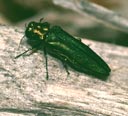 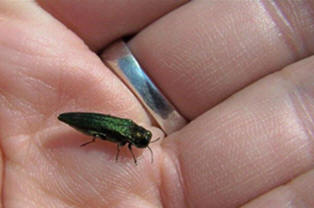
Andrew J. Storer
click image to enlarge |
The Emerald Ash Borer is only about an inch long but with a
few friends this tiny bug has been able to bring down many of
the nations mighty ash trees leaving a path of destruction from
the East toward the West... straight to the heartland. |
|
|

click image
to enlarge |
If we have learned nothing from the Dutch Elm disease it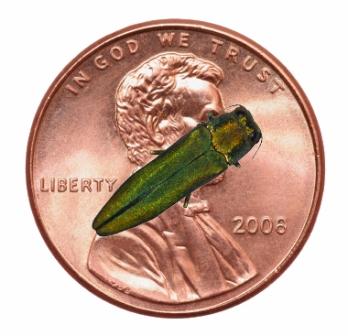 should be that there is nothing we can do to stop it.
(ref)
Some say the Borer can fly a half mile, some further. Either way
you can not isolate or "fire break" an area to prevent its
spread. Nature has a way to keep us from fixing the
"mistakes" we have made. Others might argue that it is part of
some higher plan and can not be altered. Myself, well I have a
simpler approach.... I like to stay within some practical realm
of what we are capable of doing and within reason and
affordable.
should be that there is nothing we can do to stop it.
(ref)
Some say the Borer can fly a half mile, some further. Either way
you can not isolate or "fire break" an area to prevent its
spread. Nature has a way to keep us from fixing the
"mistakes" we have made. Others might argue that it is part of
some higher plan and can not be altered. Myself, well I have a
simpler approach.... I like to stay within some practical realm
of what we are capable of doing and within reason and
affordable. |
|
For more of my sometimes "interesting" opinions on this
and other subjects such as:
- Emerald Ash Borer eradication
- My thoughts on Terminology like "Urban Forest"
- local issues such as buying boulevard trees
take a look at our Rochester Tree Service blog.
 |
What's the problem?

EAB Galleries
Andrew J. Storer
MI Tech. Univ. |
The
emerald ash borer does all of its damage as a larva that hatches and
lives in the layer between the bark and wood of the tree. This is also
the layer that transports the water and nutrients throughout the tree.
As the larva burrows throughout under the bark in tunnels (called galleries)
this flow of nutrients is slowly cut off to the tree by these tunnels.
As a result the tree
slowly dies. As you can see from the image, the galleries created by the
borer are large and very intrusive to the tree. It is very easy to see
how several of these larva can easily kill a tree if the galleries
completely shut off the flow of nutrients to the top of the tree. The
larva stage lasts over the winter months but can sometimes
continue for up to 2 years. However, they feed on the nutrient
carrying layers only for a couple of months (July - Oct) and
"hibernate" during the winter months. |
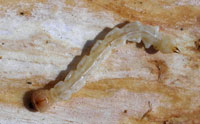
Emerald Ash Borer larva |
| |
|
|
|
| What Are The Symptoms? |
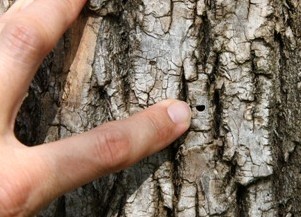 Unfortunately
it is very difficult to detect the presence of the emerald ash borer.
The only symptom is the presence of "D" shaped exit holes in the bark of
the ash tree. However, this is an indication that the tree is already
infected and the borer has already exited the tree having caused the
damage it is going to cause. It also indicates that other borers may be
active in the tree. Sadly the tree is most likely already beyond saving. Unfortunately
it is very difficult to detect the presence of the emerald ash borer.
The only symptom is the presence of "D" shaped exit holes in the bark of
the ash tree. However, this is an indication that the tree is already
infected and the borer has already exited the tree having caused the
damage it is going to cause. It also indicates that other borers may be
active in the tree. Sadly the tree is most likely already beyond saving. |
| Treatment |
| Knowing that the borer is on the way, the only
preventative measure you can do is keep an eye on the news to determine
where the borer is currently located on it's progress toward your area.
Once the borer is in striking distance of your trees, a chemical
treatment of the trees can be started. This treatment needs to continue until
the treat of the borer has run its course. This will be many years and
many dollars. |
| SUMMARY |
| The best chart that explains the emerald ash borer is a
chart provided by the University Of Missouri. This chart can be found in
its entirety at the US Forestry website...
here. Keep in mind that the larva stage of the life cycle can
sometimes be 2 years, providing more opportunity for distress to the
host tree.
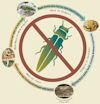 click
image to enlarge click
image to enlarge |
| |
| For Additional Information: |
 US Forest
Service US Forest
Service |
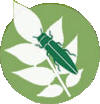 National
Emerald Ash Borer Information Website
National
Emerald Ash Borer Information Website |
| |
| |
| |